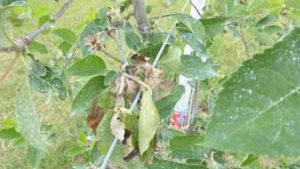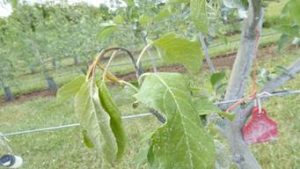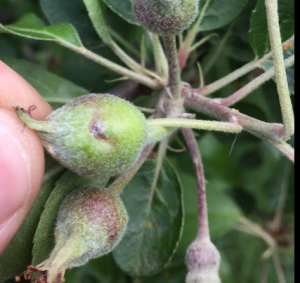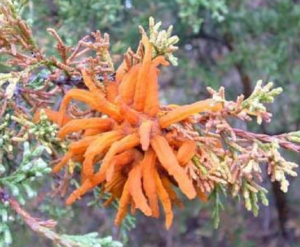By Terence Bradshaw
Below are some notes I’ve taken, including my own thoughts and observations, from today’s Champlain Valley Petal Fall meeting hosted by Cornell Cooperative Extension. Thanks to Extension Associate Anna Wallis, plant pathologist Dr. Srdjan Acimovic, entomologist Peter Jentsch, plant physioloigist Dr. Poliana Francescatto, and consultant Jim Eaves for contributing to these observations and assessments of the apple crop as we shift from bloom to managing fruit.
Disease management
Pennsylvania fruit pathologist Kari Peters was reporting detection of mature scab ascospores in her state in February, which was earlier than normally expected. The Dr. Acimovic assessed leaves collected in the Champlain Valley of New York through spore towers since late March, after the blizzard snows melted. Ascospores were mature early in April. However, comparing actual spore release data with the RIMPRO model and comparing to estimated ascospore in NEWA models indicates that NEWA is likely overestimating the infection potential for early season (pre-bloom) apple scab. Despite NEWA suggesting that scab ascospores are expended for the season, actial spore releases and RIMPRO suggest 30% of ascospores are left to be expended in the North Country this season. Combined with the five infection periods which have already occurred in most orchards leading into and though bloom, this is expected to be a significant apple scab year. Growers should maintain fungicide protection going into rain/wetting events, apply a broad-spectrum kickback material such as a Strobilurin, DMI, or SDHI the next couple of sprays, and monitor orchards closely for signs of disease for the next couple of weeks.
Fire blight was a significant event in Champlain Valley and other locations in 2016, which has increased potential for inoculum buildup in area orchards leading into 2017. While much of the spring has been cool this year, hot weather leading into bloom last week coupled with high blossom density and high inoculum suggests that growers should keep an eye out for fire blight infections this year. May 18-21 was a period of obvious high infection potential. Cool weather since then has reduced inoculum pressure and further application of streptomycin is not recommended at this point unless future model guidance suggests otherwise. Only where late bloom is occurring on highly susceptible cultivars where fire blight was present last year (cider varieties, maybe Gala or Fuji in cooler sites) should another strep spray be considered.
Some growers use post-infection copper to reduce spread of fire blight infection. Tis should be done with extreme caution since copper materials can severely russet fruit. Only materials labeled for post-bloom use should be used, and they should be applied under rapid drying conditions and in as little water per acre possible (30-50 gallons per acre).
Infection from last year have been observed in rootstocks, sometimes through suckers and especially on M9 and M26. Affected trees may not have died last year but could have looked weak and succumbed over the winter. Other potential factors implicated in recently observed tree death that may be noticed this spring and in recent years include: winter damage, especially from the winters of 2013-14 and 2014-15; herbicide damage to tree trunks; drought stress; borer (dogwood, black stem, and roundheaded apple are a few borers of concern) infestation; and other causes, and many of those are likely interacting with each other in any given orchard. When growing young trees in challenging environments as we have had in the past decade or so, all best management practices should be applied to reduce tree stress: best site selection, good orchard nutrition, pest management, groundcover management, painting trunks, avoiding herbicide contact with trunks and foliage, avoiding overcropping.
Apogee, a plant growth regulator used to reduce vegetative shoot growth, is often recommended to reduce incidence of shoot blight which typically occurs a few weeks after bloom. Application should happen when new vegetative shots are 1-3 inches long (i.e., now) and again two weeks later. Apogee takes 10-14 days to act, but reduction in carbohydrate demand from shoots during that time increases the fruit’s proportion of carbohydrate partitioning from leaves. That means that use of full rates of Apogee may reduce the carbohydrate deficit in trees and make thinning more difficult to attain. Therefore, thinning and shoot fire blight management may be at odds at this time of year. It is recommended to use lower rates of Apogee, i.e. 1-2 ounces per acre rather than a full rate of four ounces, so that you may achieve good thinning and disease management together.
Insect management
Management of certain insects during the prebloom period, even if only with oil, or even with Lorsban or pyrethroids, can be easier because there is no foliage on the trees to block penetration of materials into the bark and tree canopy. Most materials, especially oil, that are applied for mites and San Jose scale (SJS) management require absolutely thorough coverage, which is difficult to attain with an airblast sprayer. Movento is a material effective against SJS that works a little better than others at this petal fall to first cover stage in case good early season management windows were missed for applying oil. This is also the window for applying a post-bloom miticide like those listed in the New England Tree Fruit Guide.
Dogwood borer is becoming an increasing problem in the region, especially on dwarf trees with high numbers of burr knots that are also stressed by drought and other factors. As we shift especially to high density orchards on dwarfing rootstocks, trees remain susceptible to borer damage for up to ten years (compared to the 3-5 years we used to think trees were particularly susceptible to borer damage). Black stem borer is another emerging pest in some orchards that provides another reason for maintaining clean weed control around tree trunks, painting trunks white to reduce stress from solar heating, and applying trunk-drench insecticides when appropriate.
Codling moth (CM) is an increasingly problematic pest in the Champlain Valley. CM have just begun flying in area orchards, and we will be reporting on best timing for management of hatching larvae.
For now, assuming you are at full petal fall and no bees (including wild ones) are in the orchard, insecticides should only be targeted at those pests that are above threshold (none that I’ve seen yet), or plum curculio which will be migrating into the orchard with the occasional warm weather we’re expecting. In many cases, insecticide application can wait until next week.
Thinning
Trees are stressed from many causes: 2016 drought; borers; weed control (lack thereof or collateral herbicide injury); cool, cloudy weather during leaf development this spring; and as a result, may overthin easily.
Thinning applications should be based on tree row volume. We haven’t discussed this much recently, Tree row volume is a calculation method which determines orchard canopy size and the theoretic al amount of water required to saturate that canopy with an airblast sprayer, generally ranging from 100-400 dilute gallons per acre (DGA). No one is planting 400 DGA trees any more, these are the big (20+ foot) old standard trees on wide spacings; most small/high density plantings are about 150 DGA; a typical mature M.26 orchard is about 250. Do not use more than 200 DGA as a basis for determining rates. Many materials will call for a rate based on xx/100 DGA. So if your material calls for 2 oz/100 DGA and you have a mature block of M7 trees, apply 4 oz per acre. No one sprays at the full dilute gallons per acre, so if you use 50 actual gallons of water on a 200 DGA block, you are concentrating your spray 4X. 100 gallons of water applied per acre is best for thinners, definitely don’t go lower than 50.
Some other notes to consider when applying thinners:
· Trees on large rootstocks thin easier, because there is more shading in the canopy.
· Leaves formed in low light like this spring will be more responsive to thinners.
· That said, cool temperatures in the next week will reduce activity of most thinners.
· Trees less than four years old will overthin easily.
· Options for each cultivar and more specifics on thinning are, again, in the Guide.
My thoughts:
Essentially all Vermont orchards should receive a petal fall thinner application this year, it’s our best chance to break the biennial bearing habit that many of our trees are in and to produce fruit of reasonable size and quality. Where you can (no bees, no accounts that disallow it), I would start with an application of carbaryl at 1 pint or 1 pound per acre, plus a moderate (5-7.5 ppm) rate of NAA. I would not use Maxcel or other 6-BA now, until temperatures warm up. One exception, and this comes with caveats that it’s not fully tested for effectiveness, is to replace carbaryl with 7.5 ppm NAA in a mix with Maxcel. However, I just learned of this today and have not evaluated it myself.
I will follow up in a few days after we see the weather and crop develop further. Keep good notes on what you have done and, if possible, try to skip a tree or two to compare against as you evaluate your thinning program. Remember that you’re trying to remove maybe 85% of the fruit from the tree, assuming strong bloom and good fruit set, not 50 nor 95%.
Organic growers: liquid lime sulfur applied (2% solution) in combination with 1% oil (watch for phytotoxicity) can help with thinning by stressing the trees while also giving some scab control. Otherwise, start hand thinning as early as possible to get the best results on increased fruit size and return bloom.
Where trade names or commercial products are used for identification,
no discrimination is intended and no endorsement is implied.
Always read the label before using any pesticide.
The label is the legal document for the product use.
Disregard any information in this message if it is in conflict with the
label.
The UVM Tree Fruit and Viticulture Program is supported by the
University of Vermont Agriculture Experiment Station, a USDA NIFA E-IPM
Grant, and USDA Risk Management Agency Funds.








